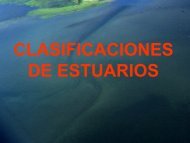Chapter 6 - Tidal Courses: Classification, Origin and Functionality
Chapter 6 - Tidal Courses: Classification, Origin and Functionality
Chapter 6 - Tidal Courses: Classification, Origin and Functionality
You also want an ePaper? Increase the reach of your titles
YUMPU automatically turns print PDFs into web optimized ePapers that Google loves.
Author's personal copy<br />
202 Gerardo M.E. Perillo<br />
smaller hydroperiod followed by vegetation growth <strong>and</strong> lateral erosion which may<br />
isolate parts of the course, specially those with me<strong>and</strong>ers that become ponds.<br />
A fourth mechanism of creek <strong>and</strong> gully erosion found <strong>and</strong> extensively studied<br />
due to the interesting physical–biological interaction was observed in the Bahía<br />
Blanca Estuary (Perillo <strong>and</strong> Iribarne, 2003a,b). One of the most surprising <strong>and</strong><br />
interesting findings is that creek formation can actually be a product of the intense<br />
action of crabs (Neohelice granulatus). In these settings, crabs first interact with a<br />
halophytic plant (Sarcocornia perennis) developing zones of high density of crab<br />
holes, which are then utilized by groundwater <strong>and</strong> tidal action to form tidal<br />
courses. When analyzing the spatial distribution of Sarcocornia, Perillo <strong>and</strong> Iribarne<br />
(2003a) discovered that the plants were mostly distributed in circles of up to<br />
1.5–8 m in diameter, with the plants concentrated in a ring along the outer<br />
portion of the circle (Figure 7a). These rings vary in width from 0.5 to 1.5 m.<br />
The central part of the circle is an unvegetated salt pan, but it is densely excavated<br />
by the burrowing crab. Burrow density reaches from 40 to 60 holes/m 2 (Figure 7b).<br />
The holes made by the crabs have a diameter of up to 12 cm (Figure 7c), <strong>and</strong><br />
they reach up to 70–100 cm into the sediment (Iribarne et al., 1997; Bortolus<strong>and</strong><br />
Iribarne, 1999). An interesting feature of the plant rings <strong>and</strong> their interaction with the<br />
crabs is the effect on the erosive process of the salt marsh in an estuary which is<br />
generally in an erosional stage. The formation of the Sarcocornia rings <strong>and</strong> the crab<br />
activity plays a major role in the erosion of the marsh transferring 1,380 m 3 of<br />
sediment from a 270 ha marsh to the estuary (Minkoff et al., 2005, 2006; Escapa<br />
et al., 2007). In 2004 alone, more than 13% (183 m 3 ) of the total sediment was<br />
exported indicating that the process keeps exporting more sediment every year in a<br />
pronounced exponential curve.<br />
The fact that the crab burrows are permanently inundated produces two effects.<br />
First, silty clay sediments (characteristic of this area) become partly loose <strong>and</strong><br />
second, the water in the holes starts to migrate, breaking intercave walls <strong>and</strong><br />
developing a groundwater stream that undermines soil. Under the pan surface,<br />
caves are formed where groundwater flows can be seen. A further stage in the<br />
development of the channel appears when soil surface fails. At this stage, the course<br />
has only a general structure filled with remnants of intercave walls (Figure 7c <strong>and</strong><br />
d), around which water circulates (Perillo <strong>and</strong> Iribarne, 2003b). The final stage is<br />
reached when the walls are eroded after a number of tides <strong>and</strong> the channel presents<br />
smooth, low-slope banks (Figure 7d). Crabs can be found along the creek banks but<br />
no plants are observed. As a result, along the creeks, the original tidal flat moves<br />
l<strong>and</strong>ward at the expense of the salt marsh, <strong>and</strong> this mechanism has been described in<br />
the previous section. Application of a Cellular Automata model (Minkoff et al.,<br />
2006) that takes into account the various active interactions existing in the marsh<br />
even makes it possible to predict the changes in the geomorphology of the terrain<br />
<strong>and</strong> the formation <strong>and</strong> evolution of gullies <strong>and</strong> creeks.<br />
At the present time, a new mechanism is being studied in the Bahía Blanca<br />
Estuary related to the development of shallow ponds (Figure 7e) over tidal flats<br />
which may either be or not be connected to creeks. These ponds may result from a<br />
complex interaction originated in the differential resistance that biofilms may<br />
produce to the flat erosion by short-period wind waves.




